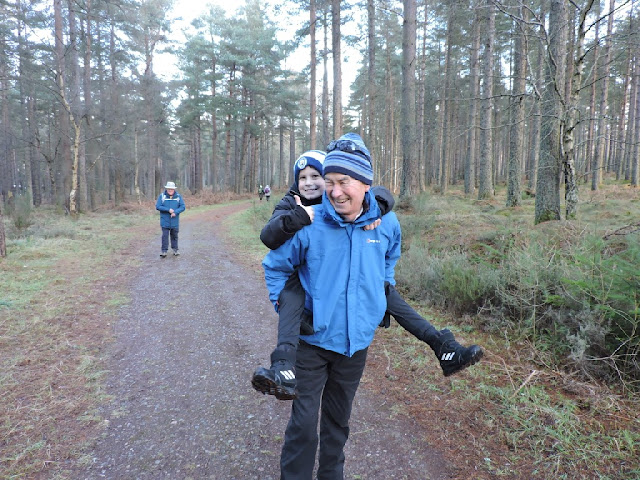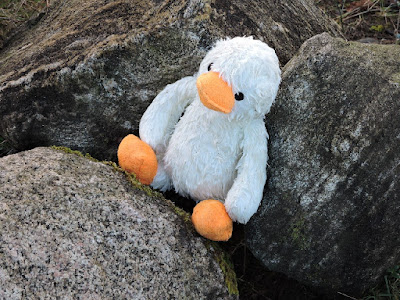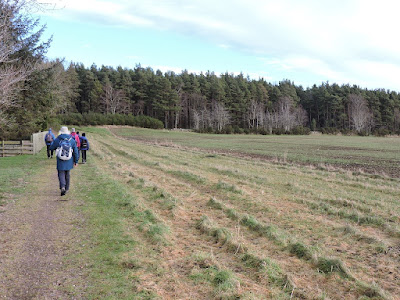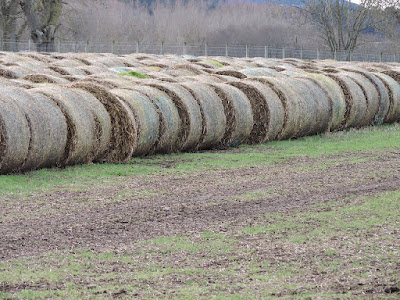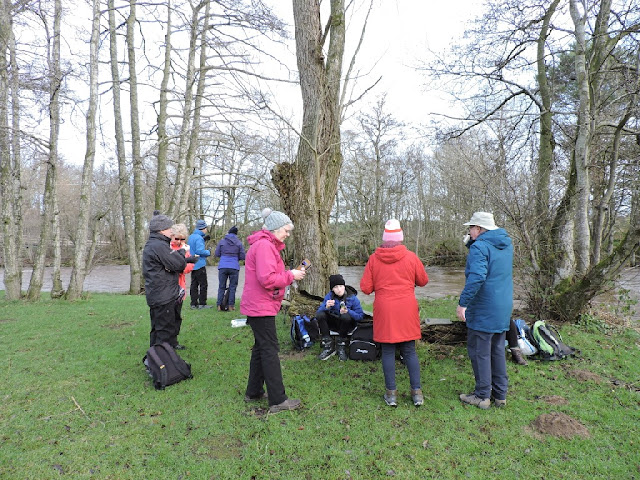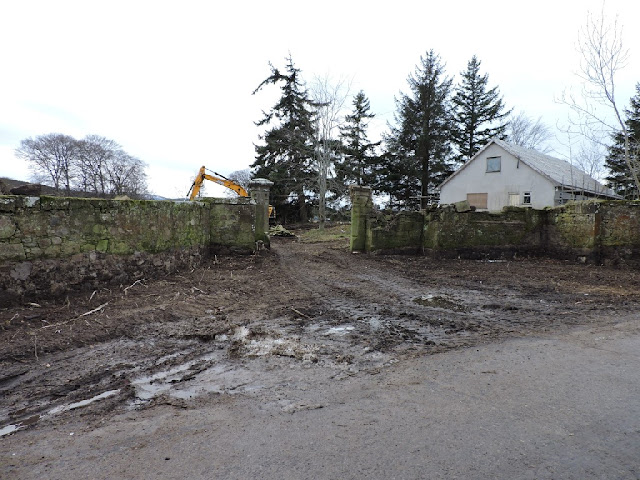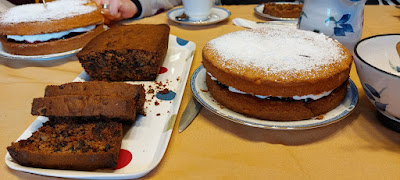CLEPHANTON
A New Year and a new walk, at least for most of us.
The weather had been pretty poor for most of January and Jim and Jacque decided that we should not be travelling too far for our first walk of the year.
Accordingly, we met up at their house and walked from there along a series of paths on Kilravock Estate that were new to most of us. They were also nice and flat, which was very helpful to those of us with problematic knees or other assorted ailments. In essence, me!
The weather might have been poor for days, but we were blessed with some bright blue skies and brilliant sunshine. It wasn't exactly The Algarve, but it was very pleasant.
The nice new path soon ran alongside the public road from Croy, which was a little on the noisy and intrusive side for a Sunday morning, but we weren't there for long.
The walking was also a bit on the slippy side, due to the remains of snow and ice. Nobody had a fall despite our advancing years.
We got away from the road side and entered a younger forestry plantation. The paths were a bit more wintry here.
We didn't know it, but we were heading roughly parallel to a line of Bronze Age burnt mounds. These are not entirely understood. They are mainly thought to be large cooking areas, as they often contain charred earth and heat-shattered stones. They were constructed so that they might hold water for cooking purposes. However, some archaeologists suggest they were used for dying fabric, or for bathing, or even for brewing beer. Whatever, the function, they were almost always located near to woodland for fuel, so the trees we were walking through might have replaced those that were harvested for a communal Bronze Age barbecue and pool party.
We had been looking after two of our grandsons whilst their parents were out carousing last night. They were keen to join us and we were keen to encourage them. It didn't take long for the younger of the two to persuade Dave that he should get a bit of a piggy back. He claims, Dave asked him, but I'm not so sure.
His brother was happy to rely on his own legs to carry him.
Young Cameron was happy to get down on his own feet once Maureen asked him to hand round the tablet! Hugh inhaled his.
We came out of the woods at the Old Military Road, which used to run from Coupar Angus via Braemar and Corgarff to Fort George. Fort George is down there next to the Firth, but I hadn't appreciated that this was a military road, so I'm afraid you will have to be content with the view down to the Black Isle.
We walked back towards Clephanton alongside the Military Road.
The sky was still blue.
Clephanton is a bit of an odd name hereabouts. It has no Gaelic tradition and, instead, derives from one of the wives of the Clan Rose, who owned Kilravock Castle and the lands roundabout. The Roses were a Norman family, who had originally settled in Dorset, but moved to the Moray Firth area, where they gained lands and built the Castle at Kilravock. Hugh Rose, the 17th Baron, was a lawyer. That would explain how he managed to entertain Bonnie Prince Charlie at Kilravock just before the Battle of Culloden, whilst the Duke of Cumberland stayed at the Rose's town house in Nairn. Talk about hedging your bets.
Anyway, Hugh, married Elizabeth Clephane. She was actually fae Fife. That, of course, is where Jim and Jacque come from. Even more spookily, she came from Cupar, which is where Hugh is from. Her ancestors had built and occupied Carslogie Castle in Cupar. When the farm toun was built nearby to where we were walking, it was named Clephanton after Elizabeth.
The sky was still blue. This jet was on the way to The Algarve, where the pool boy was getting things ready for the tourists.
Here is the pool boy, who bears a passing resemblance to Robin, who was unable to join us today. He said he had some cleaning to do......
It might be a bit warm by the pool, but we were going for some inner warmth with a bit of mulled wine.
Sandra seemed more than a little concerned that the wine would run out before she got her share.
The children amused themselves on the swings while the adults had a drink.
There were some high level cirrus clouds beginning to form. These often indicate the imminent arrival of a warm front. Storm Isha was on the way. Not too close for us to worry about on our walk, though.
We were heading north-east now, following the migratory route of the furry ducks......
....and the short legged snowy alpaca.
Out of the trees, views south to the Cawdor hills opened up.
We were walking along the edge of a very large field. It was not always thus. There had previously been a farmhouse here, but it had disappeared some time after the 1870's.
There were still some chickens about, though.
Remember the warm front of storm Isha. Well, it was getting closer and, to be perfectly honest, warm is a relative term.
We were to find out over tea and cakes, that Jimmy could imitate a buzzard. This actual buzzard sounded nothing like Jimmy. Trust me it was a buzzard, just a bit too quick for me to get a decent image.
Can you name the Blondie album. I'm pretty sure we had this at home, probably on cassette tape and, later, on CD. Now it is somewhere in the ether.
By now, we were at Milton of Kilravock farm. Of course, with a name like Milton, you would expect to see a mill. Well this was it, or at least, one gable end of it. This gable is actually thought to be the kiln end of the mill. It is has a date stone of 1641 inserted in the wall. The date stone in the south gable is for 1733. Whilst the two parts of the building might have been built at different times, a difference of nearly over 90 years might be stretching it a bit. The initials for the earlier stone are HR and MF and for 1733 HR and IW. The HR would have been Hugh Rose , Chief of the clan. One would have been the 12th Chief and the second was the 16th Chief.
Hugh Rose the 12th Laird married Magdalen Fraser.
Hugh Rose the 16th Laird married Jean Rose. She was his second wife and also his cousin. The I was often used rather than a J for names in the Latin style.
The cows were inside for the winter.
This one looks less than pleased.
After the cows, it was time for lunch by the side of the River Nairn, which was actually a bit of a raging torrent.
Dave was just saying how nobody in their right mind would go near the edge of the water.
What can I say?
Jimmy wasn't alone in getting close to the water's edge.
Cameron just wanted to get closer to me.
Time for the group lunch photo. I actually took three images. As always none of them had everyone looking at the camera. Normally it is Sandra and, indeed, she was looking elsewhere in two of the three. She was looking at the lens in the third, but someone else wasn't!
It was getting a bit cold by the river, so we did not dally, heading back west alongside the river.
The weather front was overtaking us. This was looking east towards Nairn and the juncture of cold and warm air was very clear to see.
We walked through Nairnside Farm, where I spotted this stone link between two of the buildings. I have not seen anything like this before, and I suspect this is a structural thing to tie the buildings together at wall-head height as they do not seem to be keyed together with stone or brickwork elsewhere.
However, historical research shows that this was probably the least interesting thing we should have spotted hereabouts.
Beyond the house was the site of a Bronze Age Cist Grave, containing pottery, ash and flint. Cists are generally stone graves and they are found all over Europe. On the east side of the farm, there was a prehistoric roundhouse, probably from the Bronze or Iron age. So the cist and the roundhouse date from before the Romans invaded Britain and possibly as far as 2500 years before that.
Not only that, but there was also a Lint Mill here. That was used to prepare flax fibres for spinning into linen. These were common from the 1720's to about 1800.
We were actually walking through an historic landscape, but by then we were looking forward to tea and cakes.
More history. The White Bridge was built across the river Nairn in about 1754 as part of the old military road. It was structurally unable to carry modern day traffic and it was replaced by a new road bridge just upstream in 2019.
This little plaque was erected to commemorate Paul Nichol, who built the replacement for the White Bridge that we were standing beside. He retired after the replacement bridge was built and, tragically, he was killed in a gyrocopter crash on the Black Isle a year later.
Further up the hill, Jimmy tells me that this is the site of the old gatehouse and entrance to Kilravock Castle. This doesn't feature on the National Record of the Historic Environment and nor is there reference to the drive in the listing for the castle itself. I am sure that Jimmy is correct as the alignment of the access road is clearly mapped.
What was referenced in the National Record was that a wooden dugout canoe was found just beyond the modern grain dryer that we passed. This was found in 1926 by a Captain Guy St B Watkins. I cannot trace him, but I know he was really hacked off at the time. This is because the report of the find notes that "Through the unpardonable thoughtlessness of his workmen, it was destroyed in his absence".
We were nearly back to the start of the walk and still we could see the forerunner of Storm Isha in the sky.
One last walk through the birch woods to Jim and Jacque's and we would have tea and cakes.
Boy was there cakes aplenty.
And jam!
There was also a manservant to pour the tea, albeit he managed to almost obliterate my presence with the teapot.
The boys seemed to enjoy it a lot!
Perhaps not as much or as greedily as Sandra!
A fine walk to start the year with. Many thanks to Jim and Jacque for organising the walk and providing such a splendid spread for all of us. Extra special thanks are due for actually letting all of us, particularly, the two young boys, into the house. As far as I know nothing was broken!







